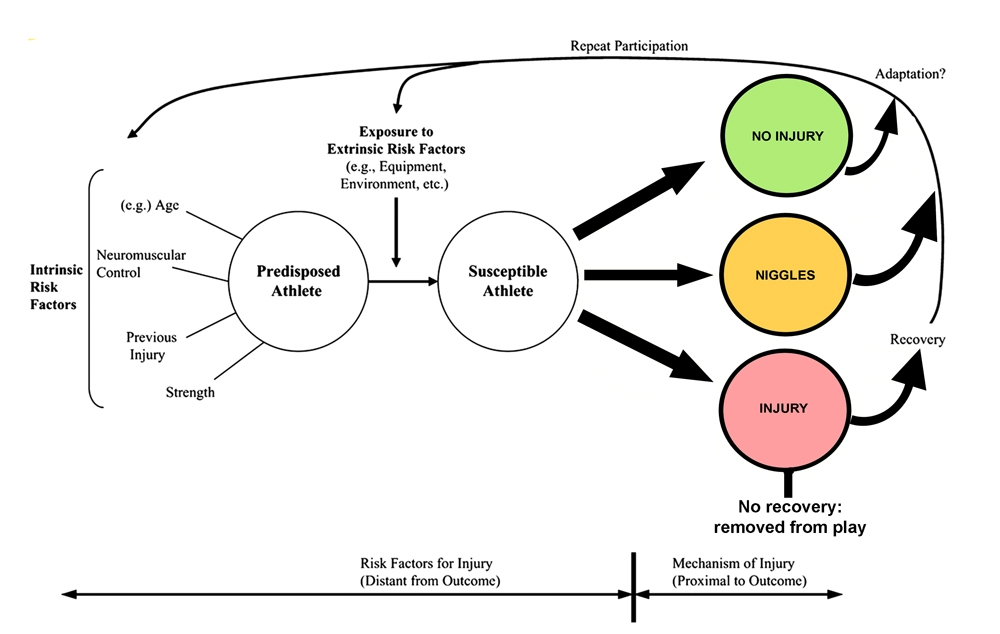Injury niggles: manage small problems for a big difference

Niggles are an accepted consequence of sports participation. Even though athletes accumulate many aches and pains through their endeavors, most agree that the benefits of sport participation outweigh the discomfort. In professional sports, pain is even considered part of the game, and a hardship that players must endure to play at the highest level. Coaches and media often revere athletes for their ability to take physical punishment year in and year out.
Rather than romanticizing the ‘no pain, no gain’ narrative, sports professionals should be honest about what’s going on here. The aches and pains associated with sports participation are not niggles. Niggle is a cute word designed to diminish the importance of what the body is telling an athlete so that they will return the field. Make no mistake; niggles are injuries. When an athlete reports a niggle, it means they are experiencing discomfort, pain, or the inability to execute a previously honed skill. The discomfort or disability may not stop them from playing, but it does indicate that they are functioning at a sub-optimal level. There is a difference between being merely fit to play and in optimal health.
Figure 1: Evidence of niggles

Rather than an effective treatment modality, kinesiology tape telegraphs that an athlete is experiencing niggles, or more specifically, feeling sub-par. The issues aren’t enough to keep them from play, especially in the Olympics, as in this picture, but can impact their comfort and performance.
Prevalence of niggles
Statistics on the incidence of pain and sub-clinical injuries in athletes are striking. A study of Australian rules footballers found that one in five players suffered an Achilles tendon injury, and one in four players sustained a patellar tendon injury during the season. However, only one in 20 players missed game time as a result of these injuries(1). These statistics mean that these players were playing with pain and an element of dysfunction. Among professional volleyball players, one study found that only one in five players reported having no niggles for two months leading up to a world-tour tournament(2). In professional rugby league players, NO PLAYER reported being pain-free at any stage of the season(3). That’s an awful lot of athletes not functioning at their best!The more days an athlete or team lose to injury, the worse they perform(4,5,6). Coaches knew this long before science caught up, which is probably how the ‘play through the pain’ narrative developed in the first place. It’s instinctive to think that keeping your best player on the field (even if she is not at her best) will lead to better results - but this may not be true.
Recursive nature of injury
Injuries occur as a result of the interaction between intrinsic risk factors, extrinsic risk factors, and an inciting event that causes the damage(7). There are differences in levels of risk between athletes due to intrinsic risk factors such as age, gender, training status, and the environmental conditions they encounter (see figure 2). As a result, a particular inciting event (eg, a jump landing during a beach volleyball match) that is usually innocuous may lead to injury under specific circumstances – for example, on a particularly hot day with a rapid increase in fatigue and a loss of neuromuscular control.Figure 2 – The dynamic recursive injury etiology model (adapted from Meeuwisse et al. (2007)(7)

Every sport exposure affects risk. Proper training makes an athlete fitter and stronger, and thus reduces risk. A particularly hard training session, however, may not cause any injury but can increase fatigue and influence an athlete’s risk at the next session. Based on this model, developing a niggle causes subtle changes in the way an athlete moves, making them more tentative in the execution of their skills. These changes, though subtle, can predispose them to injury.
Do niggles lead to more severe injuries?
Since niggles modify a player’s injury risk, is it a good idea to keep players on the field despite their twinges? Recently, a team of researchers from Australia set out to answer the question of additional risk with minor ailments(8). They asked a group of semi-professional soccer players to record all the injury niggles they experienced over a season and all of the traditional time-loss injuries (injuries that caused players to be unavailable for training or selection). The results showed that the weekly risk of injury for a fully fit player was six-percent, while for those players who reported a niggle, this risk rose to 22%. This risk is three to four times the subsequent injury rate, and means that one in five players who reported a niggle suffered a successive injury that required time off of sport!Some believe that gradual-onset injuries (those that start as niggles and evolve into serious injuries) are less impactful than traumatic injuries. After all, a player with a grade II calf strain returns to play sooner than one with a rotator cuff tear. Yet, based on the Bradford factor, multiple short-term injuries may have a more negative effect on overall team performance(9).
The Bradford factor
The Bradford factor (BF) is a metric from the field of human resource management that quantifies the effect of both frequency and duration of absences from work(9).BF = (number of incidents that require absence)2 x total days of absence per all incidents
The Bradford Factor emphasizes that shorter, but more frequent absences from work may have a more substantial effect on productivity than longer, occasional absences. This bigger impact is because frequent absences are more disruptive to team functioning. For instance, if a player had one traumatic knee injury that required 30 days off from play, their BF would equal 30. Another player might have three episodes of a chronic hamstring problem that required two days off with each flare. His BF would be 54. Therefore, the persistent problem is more disruptive than the traumatic injury.
In a sporting context, a great deal of performance in a team sport is the result of a highly coordinated understanding between team members to execute a tactical play. This understanding between players takes time to develop. When short-term injuries occur, this disrupts the team dynamic. Having the left-back unavailable for selection this week, the central midfielder inaccessible the next week, and the center back unavailable the week after that is more disruptive to team cohesion and tactical play than if any one of those players was injured for a month. When long-term absences occur, the team adjusts and develops new ways of working, but these adjustments are more difficult for frequent, short-term absences.
Managing niggles to improve injury outcomes
The dynamic, recursive injury etiology cycle works both ways! Reduce the risk of damaging exercise exposure by taking positive steps to improve recovery or function. Injury prevention programs identify modifiable risk factors and make an impact in those areas. Physios and trainers are keenly positioned to play a role in injury prevention by identifying and managing niggling injuries when they first appear.The prevalence of niggles is 20-40% in most sports(1,2,8). Dealing with this number of complaints could be crippling for the medical staff in many sports environments. However, sometimes players just want validation. Take the time to listen and document their complaints. The gold-standard way of monitoring sub-clinical injuries is to administer the Oslo Sports Trauma Research Centre (OSTRC) questionnaire weekly. At the very least, encourage players to discuss niggles during regular check-ins. If a player expresses concern, so should the medical staff. Discard the pat answer of, “You need to stretch,” and ask them about their training load, nutrition, and sleep. Adjusting one of these variables may prevent a major injury in the future and keep the athlete playing throughout the season.
References
- Scand J Med Sci Sports. 2018 Mar; 28:2016-22
- Br J Sports Med. 2009 Nov; 43:966–972
- J Sports Sci. 2016 Aug; 34(11):1067-72
- Br J Sports Med. 2013 May; 47(12):738-42
- Br J Sports Med. 2015 Nov; 50(11):651-6
- J Sci Med Sports. 2016 Oct; 19(10):778-83
- Clin J Sports Med. 2007 May; 17(3):215-9
- Sci Med Football. 2019 Dec; doi:10.1080/24733938.2019.1705996
- Sci Med Football. 2018 Mar; 2(3):173-176
You need to be logged in to continue reading.
Please register for limited access or take a 30-day risk-free trial of Sports Injury Bulletin to experience the full benefits of a subscription. TAKE A RISK-FREE TRIAL
TAKE A RISK-FREE TRIAL
Newsletter Sign Up
Subscriber Testimonials
Dr. Alexandra Fandetti-Robin, Back & Body Chiropractic
Elspeth Cowell MSCh DpodM SRCh HCPC reg
William Hunter, Nuffield Health
Newsletter Sign Up
Coaches Testimonials
Dr. Alexandra Fandetti-Robin, Back & Body Chiropractic
Elspeth Cowell MSCh DpodM SRCh HCPC reg
William Hunter, Nuffield Health
Be at the leading edge of sports injury management
Our international team of qualified experts (see above) spend hours poring over scores of technical journals and medical papers that even the most interested professionals don't have time to read.
For 17 years, we've helped hard-working physiotherapists and sports professionals like you, overwhelmed by the vast amount of new research, bring science to their treatment. Sports Injury Bulletin is the ideal resource for practitioners too busy to cull through all the monthly journals to find meaningful and applicable studies.
*includes 3 coaching manuals
Get Inspired
All the latest techniques and approaches
Sports Injury Bulletin brings together a worldwide panel of experts – including physiotherapists, doctors, researchers and sports scientists. Together we deliver everything you need to help your clients avoid – or recover as quickly as possible from – injuries.
We strip away the scientific jargon and deliver you easy-to-follow training exercises, nutrition tips, psychological strategies and recovery programmes and exercises in plain English.










